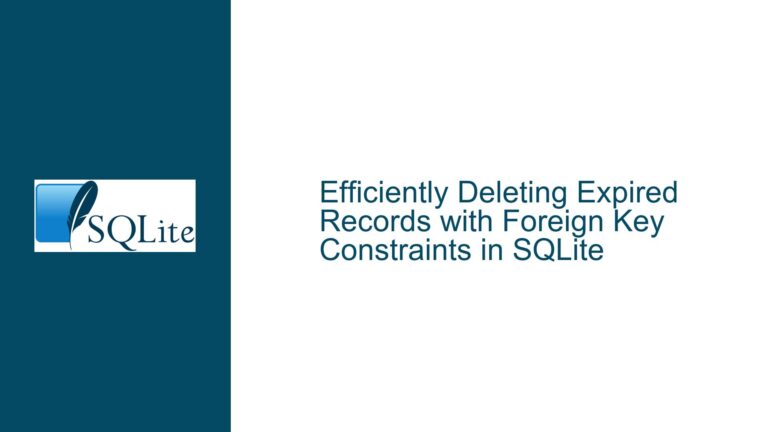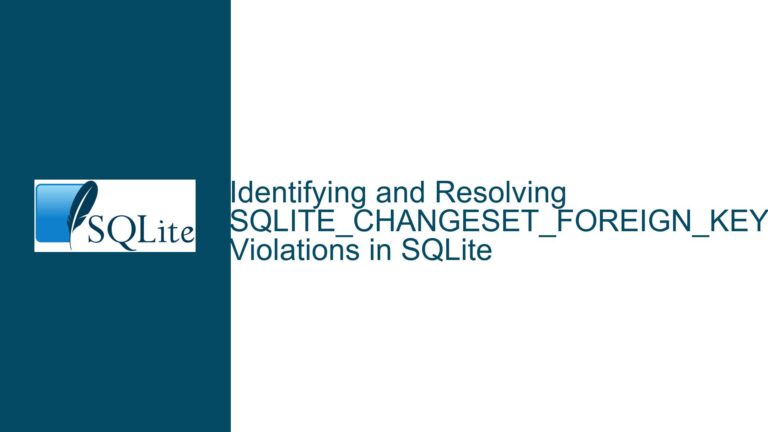Tracking Transaction Boundaries and SQL Operations in SQLite preupdate_hook Callbacks
Understanding Transaction and Statement Grouping in preupdate_hook Callbacks
The core challenge revolves around accurately associating preupdate_hook callbacks with their originating transactions or SQL statements. When using SQLite’s preupdate_hook to capture data modifications (inserts, updates, or deletes), each row-level change triggers a callback. For bulk operations like DELETE FROM xxxtable, this results in numerous callbacks—one for every row deleted. The application must insert records of these changes into a secondary "change table," but doing so naively (e.g., inserting a row for every callback) introduces significant performance overhead. Additionally, the lack of native mechanisms to group callbacks by transaction or statement complicates atomicity: if the original operation is rolled back, the corresponding entries in the change table must also be rolled back to maintain consistency.
A critical nuance lies in SQLite’s transactional model. Transactions in SQLite are explicitly controlled via BEGIN, COMMIT, and ROLLBACK statements. However, the preupdate_hook operates at the row level and does not expose metadata about the encompassing transaction or the SQL statement that triggered the change. This forces developers to infer transactional boundaries through external means. For example, a single DELETE statement modifying 1,000 rows will fire 1,000 preupdate_hook callbacks, but these all belong to the same SQL operation. If this DELETE is part of a larger explicit transaction involving multiple statements, the callbacks from all statements must be grouped correctly to reflect the transactional scope.
The problem is exacerbated by the need to handle rollbacks. If a transaction is rolled back after inserting records into the change table, those records become invalid. Caching changes in memory and inserting them as a batch after the transaction commits would improve performance but risks inconsistency if the transaction aborts. The absence of a direct linkage between preupdate_hook events and their transactional context makes it impossible to atomically manage the change table alongside the primary data modifications.
Performance and Consistency Challenges with Bulk Data Operations
The performance degradation stems from two interrelated factors: the row-level granularity of preupdate_hook and the absence of transactional context. Each callback corresponds to a single row modification, leading to an INSERT into the change table for every row affected by a bulk operation. For example, a DELETE affecting 10,000 rows would generate 10,000 INSERT statements. SQLite’s ACID compliance ensures that each INSERT is durable, but this comes at the cost of excessive disk I/O and increased lock contention. The problem is magnified in autocommit mode, where each INSERT into the change table is treated as a separate transaction, further slowing execution.
Transactional consistency introduces another layer of complexity. When an application executes multiple SQL statements within an explicit transaction, the preupdate_hook callbacks from these statements are interleaved. Without a mechanism to correlate callbacks with their parent transaction, the change table cannot accurately reflect which modifications were part of the same atomic unit. For instance, if a transaction includes an UPDATE followed by a DELETE, the callbacks from both operations must be grouped to ensure that either all corresponding change table entries are committed or none are.
The use of savepoints or nested transactions complicates this further. SQLite allows savepoints to create nested transactional states, but the preupdate_hook does not differentiate between changes made in the main transaction and those in a savepoint. If a savepoint is rolled back, the associated callbacks have already been processed, leaving orphaned entries in the change table. This necessitates a method to track savepoints and their corresponding data changes, which is not natively supported by the preupdate_hook API.
The reliance on preupdate_hook also introduces coupling between the change tracking logic and the connection’s transactional state. Since the hook is registered per-connection, it only captures changes made through that specific connection. This is often misunderstood; developers may assume the hook monitors changes across all connections, leading to incomplete or incorrect data capture. Properly managing the connection’s transactional state—ensuring that BEGIN, COMMIT, and ROLLBACK are explicitly handled—is essential but insufficient for correlating callbacks with transactions.
Alternative Approaches and Optimizations for Tracking Data Changes
Transitioning to Triggers for Atomic Change Tracking
Replacing preupdate_hook with triggers addresses both performance and consistency issues. Triggers execute within the same transaction as the triggering SQL statement, ensuring that changes to the primary table and the change table are atomic. For example, a BEFORE DELETE trigger on xxxtable can insert a row into the change table for each deleted row. Since the trigger’s INSERT is part of the original statement’s execution plan, it benefits from SQLite’s statement-level optimization. The engine compiles the trigger’s logic into the same prepared statement as the triggering DELETE, reducing overhead compared to separate INSERT statements issued from a hook.
To associate trigger-generated changes with transactions, leverage SQLite’s PRAGMA user_version or a custom sequence number. Before starting an explicit transaction, increment a global counter stored in user_version and reference this value in the trigger’s INSERT statements. This allows grouping change table entries by transaction ID. For example:
PRAGMA user_version = 123; -- Manually managed transaction ID
BEGIN;
DELETE FROM xxxtable WHERE ...;
COMMIT;
The trigger would then include user_version in the change table:
CREATE TRIGGER log_deletes BEFORE DELETE ON xxxtable
BEGIN
INSERT INTO change_table (tx_id, old_data) VALUES (PRAGMA user_version, OLD.data);
END;
This approach ensures that all changes from a transaction share the same tx_id, enabling efficient aggregation and rollback handling. Note that user_version is a database-wide value, so concurrent transactions require a more sophisticated ID generation strategy, such as using a temporary table or connection-specific identifiers.
Leveraging the Session Extension for Change Tracking
SQLite’s Session Extension provides a structured way to capture and manage changes. Unlike preupdate_hook, the Session Extension generates a changeset that can be applied atomically to another database. It automatically handles rollbacks by comparing the current database state with the changeset, ensuring that only committed changes are retained. While this requires a different architectural approach—storing changesets instead of individual rows in a change table—it eliminates the need to manually track transactional boundaries.
To use the Session Extension:
- Enable the extension in your build.
- Attach a session object to the database.
- Configure the session to track changes on specific tables.
- Generate a changeset after the transaction commits.
Example:
sqlite3_session *session;
sqlite3session_create(db, "main", &session);
sqlite3session_attach(session, "xxxtable");
// Execute transactions...
sqlite3session_changeset(session, &changeset, &nChanges);
The changeset contains all modifications made within the session’s scope, grouped by transaction. This method is particularly effective for applications requiring synchronization between databases or audit logging.
Batching Changes with Connection-Controlled Transactions
If triggers or the Session Extension are unsuitable, optimize preupdate_hook usage by batching changes within explicitly controlled transactions. This requires:
- Disabling autocommit by starting an explicit transaction with
BEGIN. - Accumulating change records in memory during the transaction.
- Inserting batched records into the change table after the transaction commits.
To handle rollbacks, use a temporary table to stage change records. During the transaction, insert into the temporary table instead of the final change table. Upon commit, atomically move the records from the temporary table to the change table. If the transaction rolls back, the temporary table is discarded. Example:
CREATE TEMP TABLE change_temp ( ... );
BEGIN;
-- Execute primary operations...
-- preupdate_hook inserts into change_temp
COMMIT;
INSERT INTO change_table SELECT * FROM change_temp;
DROP TABLE change_temp;
This approach reduces disk I/O by batching inserts and ensures atomicity. However, it increases memory usage and complexity, as the temporary table must be managed across multiple transactions.
Hybrid Approach: Combining Hooks and Triggers
For scenarios requiring both row-level detail and transactional grouping, combine preupdate_hook with triggers. Use the hook to capture metadata (e.g., operation type, old/new values) and a trigger to associate changes with a transaction ID. This decouples data capture from transaction management, allowing optimizations like batch inserts while maintaining consistency. For example:
- In the
preupdate_hook, store change data in a connection-specific temporary table. - Use a trigger to append a transaction ID to each entry in the temporary table.
- After the transaction commits, bulk-insert the contents of the temporary table into the change table.
This hybrid model balances performance and accuracy but requires careful handling of temporary storage to avoid concurrency issues.
Final Recommendations
- Use Triggers for Atomic Operations: Prefer triggers over
preupdate_hookwhen possible, as they integrate seamlessly with SQLite’s transactional model. - Leverage the Session Extension for Complex Scenarios: When auditing or synchronization is required, the Session Extension offers robust change tracking with minimal overhead.
- Batch Inserts in Explicit Transactions: If hooks are unavoidable, batch changes within explicitly controlled transactions to reduce I/O and maintain consistency.
- Avoid Autocommit Mode: Explicit transactions provide better control over when data is persisted, enabling efficient batching and rollback handling.
By understanding SQLite’s transactional semantics and leveraging its extensibility, developers can achieve efficient, consistent change tracking without sacrificing performance.





